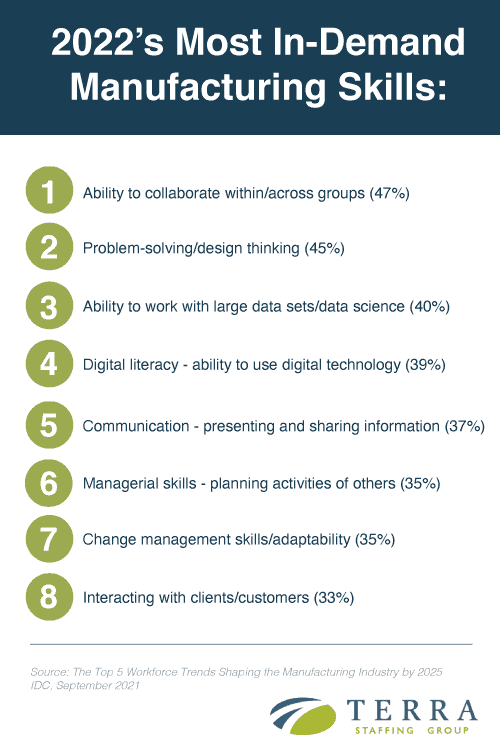HR Trends in Manufacturing: 4 Changes in 2022
Posted on January 6, 2022
The past years have seen accelerated changes to American manufacturing, and human resources professionals have faced mounting challenges. The global pandemic revealed how important the manufacturing industry is to the safety and national security of global populations, and manufacturing demand has increased and faced new challenges along the way.
The outlook for manufacturing is promising. In April 2021, McKinsey & Company identified 16 manufacturing industries that are poised to increase productivity and economic growth. These industries include those that relate to emergency preparedness, national security or resilience.
The report found the manufacturing sector uniquely positioned to strengthen post-pandemic recovery for the long-term. American manufacturing accounts for 8% of the U.S. workforce and 11% of the U.S. GDP. Manufacturing also contributes the following to the U.S. economy:
- 20% of net capital stock
- 35% of productivity growth
- 55% of patents
- 60% of exports
- 70% of R&D spending
Specialty Recruiting Services
Learn about TERRA Staffing Group’s specialty recruiting services.
Retiring Workers Increase Open Positions
Like many skilled trades industries, manufacturing faces a labor shortage. According to the Deloitte and The Manufacturing Institute’s skills gap and future of work study:
- 89% of manufacturing executives agree there’s a talent shortage in the U.S. manufacturing sector, up from 84% in 2015
- By 2028, new jobs in manufacturing are expected to grow by 1.96 million workers
- 2.6 million Baby Boomers working in the manufacturing industry will retire in the next decade. That means 2.4 million jobs may remain unfilled in 2028
Today, 45% of companies surveyed in IDC’s September 2021 whitepaper “The Top 5 Workforce Trends Shaping the Manufacturing Industry by 2025” said they’re currently understaffed in their high-skilled positions.
Manufacturing leaders need to prepare to replenish a retiring workforce. One option is for senior workers to train juniors and become mentors, which may increase older worker retention. Another option to consider is to allow older workers who are considering retirement to transition to part-time employment, so you retain skilled labor as you source new talent.
To keep up with retiring workforces, you may also want to place a bigger emphasis on employee skill sets over formal education achievements as you hire. According to IDC, the most in-demand skills in manufacturing today, cited by the corresponding percentage of manufacturing executives, are:
You can also expand recruiting efforts to trade schools or technical colleges. IDC reports 42% of manufacturers have partnerships with colleges and trade schools in place, while 41% plan to form them in the next few years. By recruiting earlier, you can create a talent pipeline that’s ready to get to work sooner.
STEM Skills Are in High Demand
Manufacturing operations are shifting from manual, human-powered processes to technology-fueled, automated operations. The use of smart devices, 3D printing, robotics, AI, 5G, quantum computing and the Internet of Things are transforming the day-to-day work in manufacturing. That means the demand for physical labor is decreasing, while the need for science, technology, engineering and mathematics (STEM) professionals is seeing an uptick.
In 2017, STEM workers made up around 2 million workers out of the 15.6 million manufacturing sector workers, according to the U.S. Census Bureau. Today’s manufacturers are no longer only competing with skilled trades recruiters. Hirers are sourcing candidates who might be considering tech jobs at places like startups.
To stay competitive in global manufacturing markets, McKinsey & Company says U.S. companies need to focus on technology adoption and process improvements. There’s also a need for more specialized manufacturing talent, including more scientists, software developers and product designers for research and development- and design-based activities. For learning-curve activities, manufacturers need industrial operations managers, production technicians and specialized engineers.
To attract more STEM experts to manufacturing, the National Association of Manufacturers and the Manufacturing Institute devised the Creators Wanted campaign. The campaign aims to draw more women, veterans and other underrepresented populations to the industry. For example, 29% of manufacturing jobs are filled by women, even though females make up around half of the labor pool.
To recruit more STEM professionals to your manufacturing organization, hirers can communicate that not all manufacturing jobs are physically demanding. Many are knowledge-based.
Also, look for talent outside of what has traditionally filled jobs in the manufacturing sector, including passive talent (skilled workers that are not actively seeking a new job). Source talent in unique places, like college robotics competitions, or through social media ads that are targeted to people with interests that fit the jobs.
You could start educating about your organization and recruiting as early as high school. You might open your location to high school tours, offer high school manufacturing internship programs or part-time jobs so students can start to plan their careers in the industry.
Manufacturing managers should look at their roles as part public relations for the industry. Hirers can make manufacturing jobs more appealing by highlighting aspects like the technology that’s used in various roles, as well as career growth and salary growth opportunities.
Another appealing feature to mention to younger STEM candidates and hands-on learners is that a career in manufacturing may be possible without having to go to a traditional 4-year university, which could result in college debt. Hirers can invite both students and parents to learn more about the great opportunities manufacturing offers.
Manufacturing Operations Need to Prioritize Skills
The skills needed for today’s manufacturing jobs will likely change in future roles. A May 2020 report by Deloitte reports 53% of business leaders said between half and all of their workforce would need to change their capabilities and skills in the next three years.
According to the IDC report, manufacturers that are seeing a shortage in skilled workers reported their operating margins were lower by an average of 13%. The skills gap in manufacturing can lead to lots of problems for your organization, including:
- Decreased operational performance
- IT security risks
- Decreased quality in product development
- Lower customer service and satisfaction
- Increased costs
- Decreased safety
- Missed product launch dates
- Lowered on-time delivery
- Increased unscheduled asset downtime
- Increased mean time to repair
A September 2020 report by Gartner stated only 16% of new hires have the skills they need for both their current and future roles. Gartner suggests:
- Prioritize skills as you define what talent you need
- Target a wider skills talent pool instead of known talent pools
- Create responsive employee value propositions, not just responsive candidates
HR professionals should also be mindful of their hiring processes to keep candidates engaged. Gartner reports 65% of candidates have cut the hiring process short because they found certain aspects of the job (company culture, development opportunities, work-life balance, etc.) unattractive.
As you hire, it’s helpful to understand the technology roadmap for your organization and update job descriptions and staffing plans accordingly. There may be less assembler jobs due to robotics use, for example, but plants will still need workers to program the machinery.
To prepare, you can future-focus your job descriptions. Instead of asking about past experience, focus more on what the candidates must possess now to do the job.
Also, look for qualities beyond manufacturing skills when hiring. Soft skills like initiative, attitude, communication and teamwork are critical to manufacturing leadership.
In addition to hiring for current and future open positions, manufacturing managers will likely need to upskill or reskill their current workforces. When you retrain current workers, you can:
- Close the skills gap
- Retain your talent
- Fill current talent in emerging jobs and eliminate positions that are no longer needed
You can encourage your workforce to develop a wide range of critical skills for your business, which can also help them grow their careers. For jobs you have difficulty filling, you might consider using automation to fill in those gaps when possible.
More Competition Impacts Retention Efforts
Because of the labor shortage, manufacturing managers must create strategies to retain the talent they have. The year 2021 saw what the U.S. Bureau of Labor Statistics calls “the Great Resignation,” where record numbers of workers across all industries quit their jobs to pursue other jobs. In an industry that is already facing labor challenges, manufacturers must implement efforts to keep their current workers.
Some strategies to consider include:
- Boost your inclusivity efforts: Empower everyone in your workforce to make strategic decisions. Adopt a less hierarchical structure that encourages workers to think beyond their own tasks and contribute in meaningful ways.
- Provide career-progression planning: Career-progression planning helps retain lower-level workers and build a pipeline of talent. Create employee development plans that include how workers can develop their skills and achieve higher compensation accordingly long-term. Career development plans can reduce turnover and increase employee engagement. According to the July 2021 Monster Job Index, 49% of workers expect their employer to support their career growth, but 80% of professionals don’t think their employer provides growth opportunities.
- Create apprenticeship or mentorship programs: Pair experienced employees with new hires so they can learn faster. Older workers who become mentors may be more likely to stay with your company, since they play a direct role in developing talent.
- Offer tuition reimbursement for continuing education: Investing in work-related education can help you retain workers with needed skills while cutting down on recruiting, hiring and job training expenses. According to LinkedIn’s 2019 Workforce Learning Report, 94% of employees said they’d stay at a company longer if it invested in helping them learn.
- Move more employees laterally throughout an organization: Lateral career moves can help employees learn a broad set of skills and discover how they want to grow in their manufacturing careers.
- Shift performance management systems from objective measurements to value-based assessments: For example, instead of measuring how much a worker produces, consider how the worker’s efforts have improved operational efficiency.
- Offer hybrid or remote work arrangements: If possible, offer hybrid or remote work arrangements. A 2021 study by Stanford University of 22,500 Americans found the average worker values the opportunity to work from home at about 8% of earnings.
Also, ensure your salary offerings and benefits package are competitive so you don’t lose your best talent to your competitors. Look at position benchmarks and compensate accordingly.
The best way to find out exactly what your workers want in terms of perks and benefits is to survey them. As you offer benefits based on employee feedback, your workforce may feel like you’re more invested in them and want to continue working for you.
Hiring in Manufacturing: Are You Prepared for What’s Next?
As we’ve seen from the past few years, what workers demand from their jobs is changing across all industries. In manufacturing, where labor shortages and emerging technology accelerate change and bring new challenges, it’s critical for managers to strategize for better recruiting, hiring and retention efforts.
If your organization needs manufacturing staffing services, we can help. At TERRA, we understand the manufacturing industry’s dynamic needs and shifting demands.
Categories: Innovation & Change Management, Staffing Tips & Recruiting Trends
Tags:






